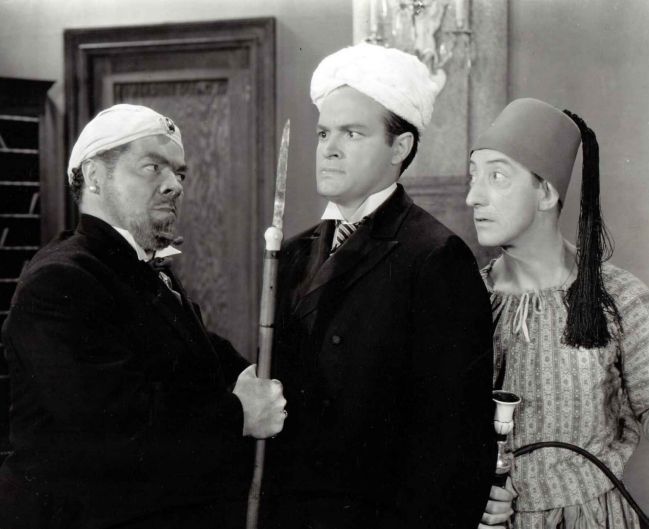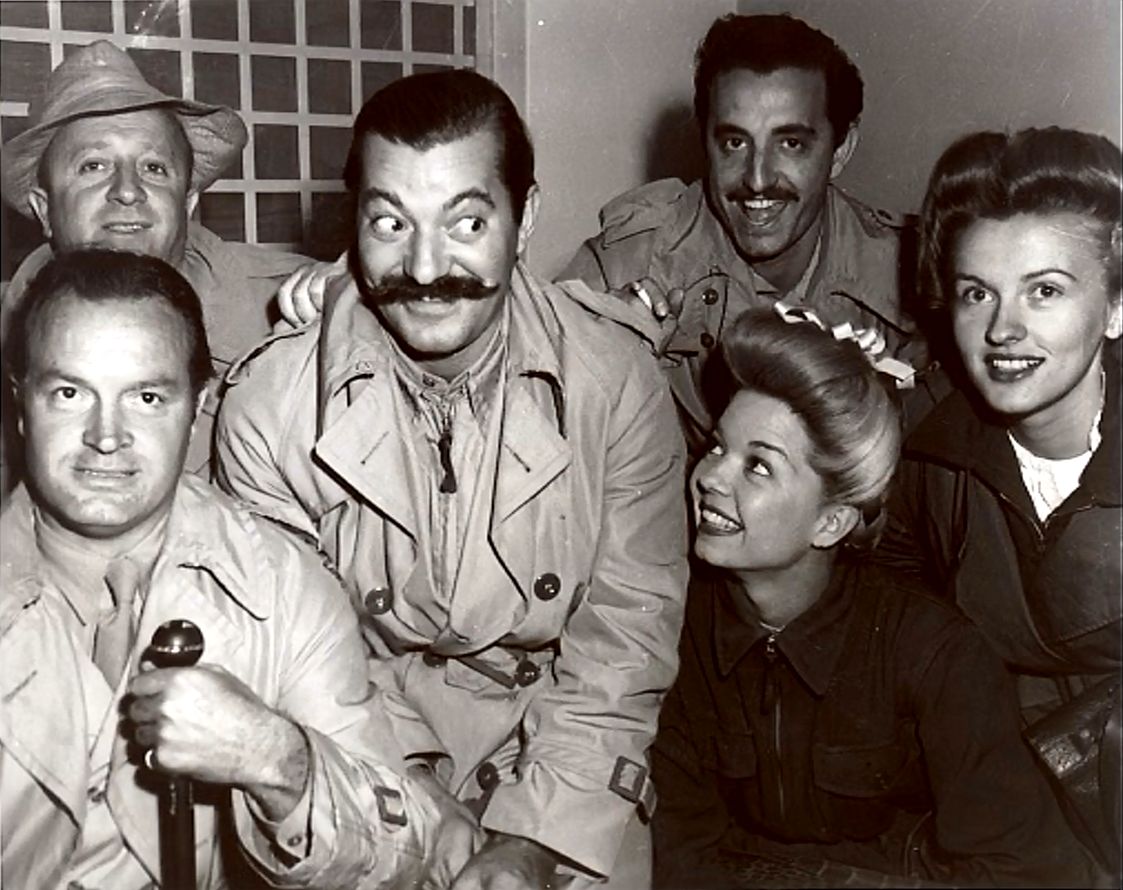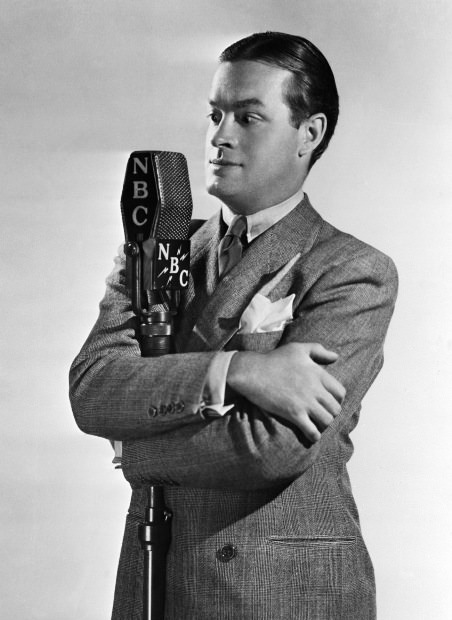Happy Birthday, Bob Hope!
Posted by Ivan G. Shreve, Jr. on May 29th 2017
We’re commemorating Memorial Day today…and it seems only fitting that the entertainer who established his legacy performing in United Service Organizations (you know it as the USO) shows for the benefit of active duty American military personnel (he made 57 tours for the USO between 1941 and 1991) should be celebrating a birthday on this date as well. The man born Leslie Townes Hope in Eltham, Kent, England in 1903 is better known to us as Bob Hope—and he plied his talents for song, dance, and witty patter to conquer stage, screen (both silver and small) and radio for over seventy-five years…becoming an American institution in the process.
Hope adopted the “Bob” in 1929. There are several versions as to why he made this decision, but the comedian himself frequently noted in interviews that he chose the new name because it had a friendly “Hiya fellas!” ring to it. Since his arrival in the U.S. in 1908 with his parents and brothers (his father Harry was a stonemason by trade), Bob was often teased by the neighborhood kids in Cleveland, OH (where the family eventually put down stakes) for his British accent and given name of “Leslie.” When the young Hope started referring to himself as “Les,” the kids redoubled their efforts and nicknamed him “Hopeless.” To handle his tormenters, Bob became quite the scrapper, and he even had a brief career as a pugilist in 1919 (fighting under the name “Packy East”).
But since the age of four, the young Hope had practiced mimicry and loved to sing and dance. He earned pocket money singing, dancing, and performing comedy from the age of twelve, and winning a prize in a talent contest in 1915 for an impersonation of Charlie Chaplin only whetted his appetite for a show business career that much more. After tryouts in various occupations, including a butcher’s assistant and a lineman, Bob and his then-girlfriend signed up for dancing lessons in their determination to pursue a show business career. Bob would form a partnership with a friend from the dancing school, Lloyd Durbin, and the duo got much encouragement from movie comedian Roscoe “Fatty” Arbuckle, who found them work in 1925 with a troupe known as Hurley’s Jolly Follies. A year later, Hope would team up with George Byrne and the infamous Hilton Sisters (Siamese twins Daisy and Violet) to form an act known as the Dancemedians. By 1928, Bob was performing solo, telling jokes in blackface…until one day, having arrived late for a theatre date, Bob didn’t have time to apply his makeup and so he went without it. The theatre manager told him after his performance he was funnier without the burnt cork.

Bob Hope’s expertise with one-liners and zingers soon made him a top performer in vaudeville and allowed him to expand his horizons on the New York stage. He performed in plays and musical revues, with his big Broadway break coming with his role as “Huckleberry Haines” in Roberta (a show that also featured Sydney Greenstreet, Fred MacMurray, and George Murphy). While he was wowing them in the aisles with that production, he agreed to have a go at motion pictures. He agreed to appear in a series of shorts for Educational Pictures, the first being Going Spanish in 1934. (Hope famously told Walter Winchell: “When they catch John Dillinger, they’re going to make him sit through it twice.”) Bob didn’t stay with Educational long but did agree to do a series of comedy two-reelers for producer Sam Sax and Vitaphone. (This accommodated the entertainer’s schedule quite nicely: he made movies by day and performed on stage at night.)
Bob’s motion picture breakthrough came when Paramount Pictures signed him to make his first feature film, The Big Broadcast of 1938. Despite a high-wattage celebrity cast that included W.C. Fields, Martha Raye, Dorothy Lamour, Lynne Overman, and Ben Blue, Bob walked off with the picture by performing an unassuming musical number with Shirley Ross: Thanks for the Memory. The wistful tune not only won the Academy Award for Best Original Song…it provided the comedian with his signature theme for the rest of his show business career. His success in Big Broadcast resulted in his landing The Pepsodent Show Starring Bob Hope in the fall of that same year, a half-hour program that quickly raced to the top of the Hooper ratings for NBC on Tuesday night radio. It should be stressed that this was not Bob’s first radio showcase—he had performed before a microphone as far back as 1935 on the Blue Network’s The Intimate Revue and followed that with stints for Atlantic Oil (CBS’ The Atlantic Family, from September 1935 to September 1936), Woodbury Soap (The Rippling Rhythm Revue for Blue in 1937), and Lucky Strike (NBC’s Your Hollywood Parade from December 1937 to March 1938).
The success of the Pepsodent show symbiotically boosted Bob Hope’s movie career. He continued to make successful features for Paramount, including 1938’s Thanks for the Memory (capitalizing on his famous theme song) and 1939’s The Cat and the Canary (a wildly successful remake of the 1927 film). With co-star Paulette Goddard, Bob deftly mixed laughs and scares in this comedy classic (the two of them would reunite for 1940’s The Ghost Breakers and 1941’s Nothing but the Truth) and proved to Paramount his viability as a leading man. Success after success followed, with a string of comedies that are loved by fans today (Caught in the Draft, My Favorite Blonde)…but the best was yet to come when the studio decided to dust off a property that they had originally envisioned for George Burns and Gracie Allen: Road to Singapore (1940). Bob was teamed with actor-crooner Bing Crosby (with Dorothy Lamour added for saronged spice) in a conventional but fun vehicle that led to a series of six “Road” films after the initial entry…each one wackier than the one before. (Bob and Bing formed a solid friendship, and their “feud”—every bit as counterfeit as the one between Jack Benny and Fred Allen—convulsed radio audiences whenever the two men would guest star on each other’s shows.)

March 6, 1941 was a very important date in the history of Bob Hope’s radio program. It marked the very first time that he performed for an audience of military troops (at March Field, California). From that moment on, Hope became radio’s official goodwill ambassador, taking his show and cast to any number of military bases and camps in his belief that “GIs are the greatest audiences in the world.” Though many of his fellow radio comedians would follow suit (Jack Benny, Burns & Allen), none of them performed with the same devotion and enthusiasm as Bob. He and his cast of regulars (Frances Langford, Jerry Colonna, Vera Vague, etc.) went anywhere and everywhere to provide entertainment for the men and women who needed it the most. Bob Hope was a human dynamo—not only maintaining a grueling schedule of performing USO shows but continuing to thrive in his film career with box office successes like The Princess and the Pirate (1944) and Monsieur Beaucaire (1946).
When World War II ended, the popularity of Bob’s radio program began to wane. His show still got respectable ratings, but audiences were starting to tire of what they felt was a staleness in his formula. Pepsodent relinquished sponsorship in the fall of 1948 to Swan Soap, and Bob decided to “shake things up” by adding new regulars like vocalist Doris Day (whom he inherited when his future longtime bandleader Les Brown joined the program) and Irene Ryan (taking over for Vera Vague). Bob held on to radio longer than his contemporaries (only Edgar Bergen outlasted him), and while he never regained the momentum of the war years, he was still an audience favorite. You could argue that, in a sense, Hope didn’t need radio—his movie career was going great guns (My Favorite Brunette, Where There’s Life), and in 1948 he scored another box office triumph with The Paleface. (The song Buttons and Bows would win an Oscar statuette, too.) Paleface was so successful that the comedian did a sequel in 1952 with Son of Paleface—which happens to be my favorite of his feature films.

With his red-hot movie career, Bob Hope didn’t need to commit to a regular TV series like radio comedians Jack Benny and Red Skelton—Hope settled for the occasional small screen special and guesting on the popular variety shows of the day. His Christmas specials (many concentrating on the USO shows he performed for military audiences overseas) always drew big boob tube audiences, and he still holds the record for having emceed the yearly Oscars telecasts (though some of that hosting was done during his years on radio). Bob Hope once famously remarked at the event in 1968: “Welcome to the Academy Awards…or as they’re known at my house, Passover.” (Hope was green with envy that his “Road” companion Bing Crosby had won an Oscar for his performance in 1944’s Going My Way…and though he tried to get notice for serious turns like those in The Seven Little Foys [1955] and Beau James [1957], the comedian had to settle for five honorary trophies (including the prestigious Jean Hersholt Humanitarian Award), presented to him between 1941 and 1966.
The Guinness Book of World Records notes that Bob Hope holds the record for “most honored entertainer.” Among the many tributes he received were a Congressional Gold Medal (presented to him by President John F. Kennedy in 1963) and the Presidential Medal of Freedom (President Lyndon Johnson in 1969). He continued making theatrical films (his last starring movie was 1972’s Cancel My Reservation) and top-rated TV specials for four more decades – the later due to another Guinness record: the entertainer with “the longest running contract with a single network (NBC)—spanning 61 years.” Simply put, Bob Hope was on many individuals’ lists as “The Entertainer of the 20th Century” …and with his passing in 2003, he himself reached the century mark when he died at the age of 100.

In honor of Memorial Day, we recommend the DVD Bob Hope: Entertaining the Troops—a 1994 documentary originally broadcast on PBS that not only highlights how radio stars gave their all for the war effort, but features fascinating background detail on our birthday boy’s efforts to make certain those individuals knew there was “no place like Hope for the holidays.” (Bob is even reunited with some of his fellow entertainers, including Frances Langford—we reviewed the release in this space here.) Bob is also present and accounted for on the DVD collection Funniest Moments of Comedy, and does a “telephone cameo” in the 1950 short You Can Change the World that’s featured on Stars in Their Shorts. For the musical side of Hope, the You Ain’t Heard Nothing Yet! Showstoppers CD features a rendition of his theme song, Thanks for the Memory, and a duet with Shirley Ross (from the film Thanks for the Memory), Two Sleepy People. On The Good Old Boys Club: Solos, Duos, Trios and Four-O’s!, Bob duets with singer Jimmy Wakely on a pair of numbers featured in Son of Paleface: There’s a Cloud in My Valley of Sunshine and Four-Legged Friend. With a Song in My Heart: Hooray for Hollywood lets Bob loose on Buttons and Bows (from The Paleface) and teams him with his “Road” buddy Bing Crosby on The Road to Morocco.
Whoops—I almost forgot Bob on radio! There’s a Screen Directors’ Playhouse broadcast from 1950 that allows Bob to reprise his famous role from The Paleface on Comedy Goes West, and Hope double-dates with Jack Benny in a riotous April 17, 1955 broadcast available on Jack Benny: The Fabulous ‘50s. Top that off with an episode of Bob’s The New Swan Show from December 7, 1948 (“Put somethin’ in the pot, boy…”) on Radio’s Christmas Celebrations…and I’ll bet you’ll soon be thanking us for the memories. Happy birthday, Bob!

